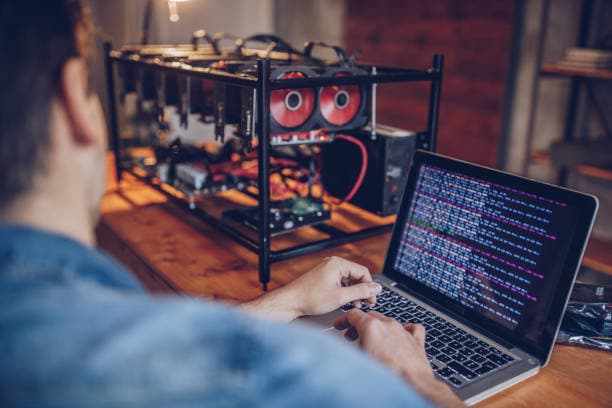Bitcoin mining is the process of creating new bitcoins by solving algorithmic problems. This process has been compared to resource extraction on Earth because, just as minerals are extracted from the earth, bitcoins are “extracted” from the digital network. Miners use powerful computers to solve complex mathematical problems, and successfully solving these problems results in the creation of a new block in the bitcoin blockchain.
How Does Mining Work?
People who engage in mining are called miners. They use specialised equipment to solve mathematical puzzles, which are long sequences of numbers. When a miner solves such a problem, he or she receives a reward in the form of bitcoins. This reward is known as a block reward because a new block of data in the bitcoin blockchain is created each time a problem is solved.
Impact of Mining on the Blockchain
Each successful mining operation not only creates a new bitcoin, but also updates the blockchain, the central registry of all bitcoin transactions. This process adds a new block to the blockchain, which helps keep the entire network secure and up-to-date.
Why Is Mining Important?
Bitcoin network upkeep and growth depend on mining. This operation adds additional bitcoins to circulation and secures the blockchain system. Since each new transaction requires confirmation and addition to the common record, miners help ensure blockchain transparency and continuity by solving mathematical puzzles.
Mining safeguards the network from manipulation and assaults. The intricacy of the mathematical difficulties needed to mine a new block prevents attackers from altering the transaction record. The more miners participate, the more secure the system, as modifying blockchain information needs majority permission.
Bitcoin administration is decentralised by mining. Mining gives everybody with the right equipment an equal chance to maintain and expand the network, preventing major players from dominating and supporting bitcoin’s decentralisation.
Mining also keeps the blockchain updated, which ensures transaction continuity and relevancy. The bitcoin blockchain is one of the most secure digital assets since each new block strengthens the previous ones.
How Do Miners Get Rewarded?
Miners are rewarded for their work in the form of bitcoins when they successfully solve a mathematical problem and add a new block to the blockchain. This process is a major source of income for miners and an incentive to continue to support the network.
The block reward was originally conceived as a mechanism that rewards miners for their contribution to processing transactions and maintaining the operational stability of the network.
The value of the reward is determined by the bitcoin protocol and decreases over time in a process known as halving.
Halving occurs every 210,000 blocks, approximately four years, and is designed to control inflation within the system by gradually reducing the number of new coins issued into circulation.
History of changes in the reward per block:
- 2008: The reward was 50 bitcoins per block. This was set when the network was created to incentivise participation in the new digital currency.
- First Halving: After the first 210,000 blocks, the reward dropped to 25 bitcoins per block.
- Second halving: The reward decreased to 12.5 bitcoins.
- Third halving: The last known halving reduced the reward to the current 6.25 bitcoins per block.

When Will Bitcoin Mining End?
Bitcoin mining will continue until the last, 21 million bitcoin is mined. The design of the Bitcoin system places a strict limit on the total number of coins that will ever be created, and that number is 21 million. According to the current algorithm and network rules, the last bitcoin is expected to be mined around 2140.
This long mining process is due to a halving mechanism that reduces the reward per block every 210,000 blocks, or roughly every four years.
This feature slows the rate at which new bitcoins are put into circulation and is designed to mimic the diminishing returns from mining as resources are depleted.
Estimated end-of-mining trajectory:
- Initial reward: At the beginning of Bitcoin’s existence, the reward per block was 50 bitcoins.
- Subsequent halving: With each halving, the reward is halved, making mining less profitable in terms of the number of bitcoins mined per block solved.
As a result, by the time mining ends, the reward per block will be so small that mining the last coins will be extremely slow.
Conclusion
Bitcoin mining is an integral part of the Bitcoin ecosystem that keeps the entire network functioning and secure. Halving provides a controlled and predictable decrease in the output of new coins, which helps prevent inflation and maintain the value of bitcoin.
As we approach the final number of bitcoins, the importance of mining as a blockchain support process will only increase, maintaining its vital role in the Bitcoin network.